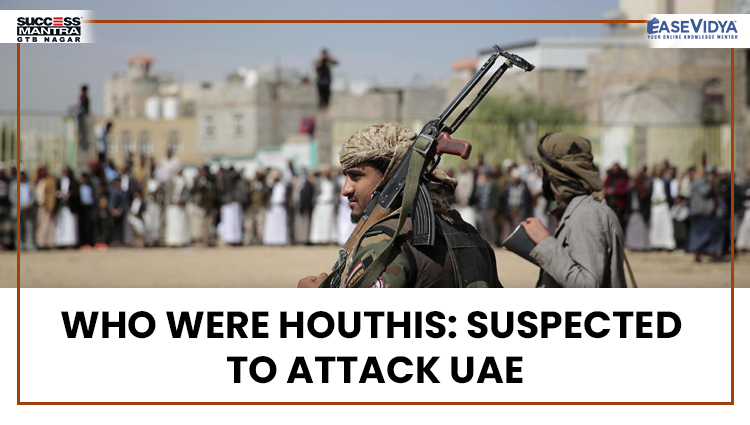
WHO WERE HOUTHIS:SUSPECTED TO ATTACK UAE
WHO WERE HOUTHIS: SUSPECTED TO ATTACK UAE
A suspected drone attack on three petroleum tankers in Abu Dhabi, the capital of the United Arab Emirates, left three persons — two Indians and a Pakistani national — dead. Later, the Iran-backed Houthi rebels in Yemen claimed responsibility for the attack, warning that the “UAE is an unsafe state as long as its aggressive escalation against Yemen continues.” One of the Arab world’s poorest countries, Yemen has been devastated by a nearly seven-year civil war, which started after Houthis captured the capital Sana’a, following which Saudi-led forces intervened and fought the rebels with the aim of ending Iranian influence in the region and restoring the former government. The UAE joined the Saudi campaign in 2015 and has been deeply involved in the conflict ever since, despite announcing the formal withdrawal of its forces in 2019 and 2020. Earlier in 2021, there was a ballistic missile attack by the Houthis on the Saudi capital Riyadh.
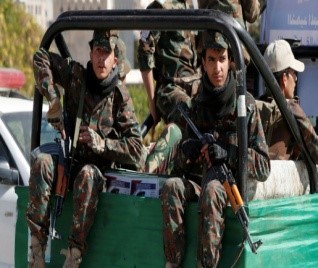
Current Affairs Notes By Success Mantra Coaching Institute GTB Nagar Delhi CLICK HERE
WHO WERE HOUTHIS?
The roots of the Houthi movement can be traced to “Believing Youth” (Muntada al-Shahabal-Mu’min), a Zaydi revivalist group founded by Hussein al-Houthi and his father, Badr al-Din al-Houthi, in the early 1990s. Badr al-Din was an influential Zaydi cleric in northern Yemen. Inspired by the Iranian revolution of 1979 and the rise of Hezbollah in southern Lebanon in the 1980s, Badr al-Din and his sons started building vast social and religious networks among the Zaydis of Yemen, who make up roughly one-third of the Sunni-majority country’s population. But when the movement turned political and started attacking the “corrupt” regime of Ali Abdullah Saleh (in Yemen) and his support for the US’ war on terror, it became a thorn on Saleh’s side. They called themselves Ansar Allah (Partisans of God), mobilising tribesmen in the north against the government. In 2004, Saleh’s government issued an arrest warrant against Hussein al-Houthi. He resisted the arrest, starting an insurgency. In September 2004, the government troops attacked the rebels and killed Hussein. Since then, the government launched multiple military campaigns in Sa’dah, the Zaydi stronghold, to end the resistance, which was locally called the Houthis movement, after their “martyred” leader. But it only strengthened the Houthis, who, by 2010, when a ceasefire was reached, had captured Sa’dah from the government troops.
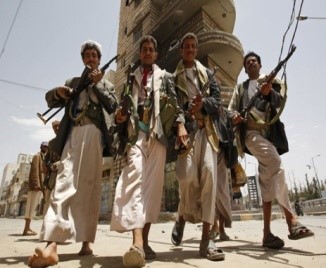
BACKGROUND OF ZAYDIS & THEIR ORIGIN
Zaydis are the oldest branch of the Shia. The Zaydis are named after Zayd Bin Ali, the great grandson of Imam Ali, Prophet Mohammed’s cousin and son-in-law who Shias, Sunnis and Zaydis revere. Zayd Bin Ali had led a revolt against the Umayyad Caliphate in the eighth century. He was killed, but his martyrdom led to the rise of the Zaydi sect. While the Zaydis are seen part of the Shia branch of Islam, both in terms of theology and practice, they are different from the ‘Twelver’ Shias of Iran, Iraq and Lebanon. For centuries, the Zaydis were a powerful sect within Yemen. After the collapse of the Ottoman Empire in 1918, the Zaydis would establish a monarchy (the Mutawakkilite Kingdom) in the country. But their dominance would come to an end in 1962 when the Egypt-backed republicans overthrew the monarchy.
REASON FOR HOUTHIS RISE
When protests broke out in Yemen in 2011 as part of the Arab Spring protests that felled Tunisian and Egyptian dictators, the Houthis, now confident from their military victories and the support they enjoyed in Sadah, backed the agitation. President Saleh, a Zaydi who was in power for 33 years, resigned in November 2011, handing the reins to his deputy, Abdrabbuh Mansur Hadi, a Saudi-backed Sunni. Yemen, under the tutelage of Saudi Arabia and the UAE, started a national dialogue to resolve internal differences. The Houthis were part of the dialogue. But they fell out with the transitional government of Mr. Hadi, claiming that the proposed federal solution, which sought to divide the Zaydi-dominated north into two land-locked provinces, was intended to weaken the movement. They soon got back to insurgency. Saleh, who was sidelined by the interim government and its backers, joined hands with his former rivals and launched a joint military operation. By January 2015, the Houthi-Saleh alliance had captured Sana’a and much of northern Yemen, including the vital Red Sea coast. (Later the Houthis turned against Saleh and killed him in December 2017).
Reason for Saudi Arabia’s Attack on Yemen:
The rapid rise of the Houthis in Yemen set off alarm bells in Saudi Arabia which saw them as Iranian proxies. Saudi Arabia started a military campaign in March 2015, hoping for a quick victory against the Houthis. But the Houthis had dug in, refusing to leave despite Saudi Arabia’s aerial blitzkrieg. With no effective allies on the ground and no way-out plan, the Saudi-led campaign went on with no tangible result. In the past six years, the Houthis have launched multiple attacks on Saudi cities from northern Yemen in retaliation for Saudi air strikes. In 2019, the Houthis claimed the attack on two Saudi oil installations that knocked out, briefly, half of the kingdom’s oil output (the Houthi claim was disputed by experts and governments, who said the attack was too sophisticated for the rebels to carry out. The US has blamed Iran). The Houthis have established a government in the north. There are serious allegations against both the Saudis and the Houthis in the war. While the Saudi bombings caused a large number of civilian deaths, the Houthis were accused, by rights groups and governments, of preventing aid, deploying forces in densely populated areas and using excessive force against civilians and peaceful protesters.
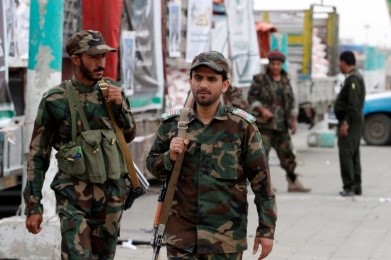
REASON FOR HOUTHIS ATTACKING UAE
This is not the first time the Houthis attacked the UAE. In 2018, when the UAE-backed forces were making advances in Yemen, the Houthis claimed attacks against the Emirates. Since then, the UAE pulled out its troops from Yemen and offered tactical support to the Southern Transitional Council, a group of rebels based in Aden, that was also fighting the Saudi-backed government forces of UAE. During this period, the Houthis stayed focussed entirely on Saudi Arabia and Saudi-backed forces inside Yemen. But in recent months, Giants Brigades, a militia group largely made up of Southern Yemenis (backed by the UAE) and the Joint Forces (the militia led by a nephew of the slain former President Saleh) turned their guns against the Houthis. Now with the attacks the Houthis appear to have sent a clear message to the Emiratis — stay out of Yemen or face more attacks.
PRAVAHINI Current Affairs Notes By Success Mantra Coaching Institute GTB Nagar Delhi CLICK HERE
INDIA'S INTEREST
For India, it is a challenge which cannot be washed away taking into consideration the oil security and 8 million expats living in the region with more than USD 80 billion of incoming remittance annually.
Indian Initiatives:
- Operation Rahat: India launched a massive air and sea operation to evacuate over 4000 Indian nationals from Yemen in April 2015.
- Humanitarian Assistance: India has provided food and medical aid to Yemen in the past and thousands of Yemeni nationals have availed of medical treatment in India over the past few years. India also continues to facilitate education of a large number of Yemeni nationals in various Indian institutions.
DRAFT DRONE RULES 2021 IN INDIA
- The Ministry of Civil Aviation has unveiled the Draft Drone Rules, 2021 based on “trust, self-certification and non-intrusive monitoring”. The new rules would replace the existing Unmanned Aircraft System (UAS) Rules, notified in March, 2021.
- Aim: To create a “digital sky platform” as a business-friendly single-window online system for procuring various approvals. There will be minimal human interface on the digital sky platform and most permission will be self-generated.
Provisions:
- Approvals: Abolish the need for various approvals, including certificate of conformance, certificate of maintenance, import clearance, acceptance of existing drones, operator permit, authorisation of R&D organisation and student remote pilot licence. Fee reduced to nominal levels. No linkage with the size of the drone.
- Digital Sky Platform: The government will be developing a digital sky platform that will have an interactive airspace map dividing the country into green, yellow, and red zones. It will provide a secure and a scalable platform that supports drone technology frameworks, such as NPNT (no permission, no take-off), designed to enable flight permission digitally and manage unmanned aircraft operations and traffic efficiently.
- Reduced Airport Perimeter: The draft rules reduced the airport perimeter from 45 km to 12 km. The rules state that no flight permissions would be required to fly upto 400 feet in green zones and upto 200 feet in the area between 8 and 12 km from the airport perimeter.
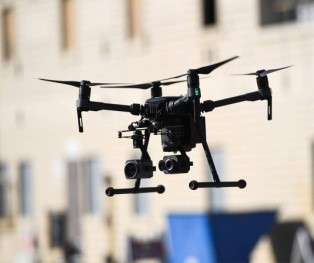
WHAT ARE DRONES?
Drone is a layman terminology for Unmanned Aircraft (UA). There are three subsets of Unmanned Aircraft- Remotely Piloted Aircraft, Autonomous Aircraft and Model Aircraft. Remotely Piloted Aircraft consists of remote pilot station(s), the required command and control links and any other components, as specified in the type design. Remotely piloted aircraft have been divided into five categories based on their weight (existing rules)-
- Nano: Less than or equal to 250 grams.
- Micro: From 250 grams to 2kg.
- Small: From 2 kg to 25kg.
- Medium: From 25kg to 150kg.
- Large: Greater than 150kg.












0 Comment